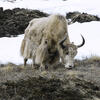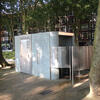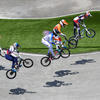You are here
Sport, a Reflection of our Societies

Of course France, which will see the Olympic flame shine in the Parisian sky during the summer of 2024, is not riding high atop European sporting nations, unlike the Netherlands or Germany. And yet! According to the most recent major explorations of sports practice in France, commissioned by the Ministry for Sports (2018),1 nearly two thirds of those aged 15 years or older regularly practice a physical or sports activity at least once per week. This is a reassuring figure considering that such enthusiasts numbered just 30% during the 1960s.
Each weekend tens of thousands of fans attend sporting events, whether free or not, and never before has there been such a craving for images, nor such a bountiful supply of them across all mediums. The achievement of the French national team during the World Cup on 15 July 2018 was watched live by 19.9 million viewers on the TF1 and beIN Sports channels (or 34.6% of the population), and by a billion others across the globe.
Whether one practices a sports activity or not, or does so for leisure or within an educational context, our everyday lives are steeped in sport. It shines by virtue of its social and media pervasiveness. “When you open a newspaper, there is information on sports in specialized pages of course, but also in the sections covering economics, politics, international, cultural, and minor news items,” observes Thierry Terret, ministerial delegate for the 2024 Olympic and Paralympic Games. “Modern sport, which was born in schools of the English elite in the mid-nineteenth century, when teachers transformed brutal and chaotic game contests into competitions organized to discipline turbulent young students, occupies a central role in our society. It is therefore an excellent reflection of how our society functions, its ideology and values, choices in matters of public policy, and weaknesses and excesses.”

Sports is simultaneously a conveyor of wellness, global idiom generating collective emotions, machine for producing heroes, driver of growth, instrument of national prestige, lever for diplomatic action, and a reflection of the state of international relations. “Sport has become a kind of majority culture in the West,” adds Jean-Paul Callède, from the Groupe d’études des méthodes de l’analyse sociologique de la Sorbonne (Gemass),2 and a member of the historical committee of the ministries in charge of Youth and Sports. We now use less and less bodily energy in productive work and laborious tasks (industry, agriculture...), and more and more in sporting effort.
This “sportification” of habits and bodies is partly linked to the “collapse of major religious and political transcendences, the triumph of materialism, and hypervaluation of the body,” indicates Isabelle Queval of the Institut national supérieur de formation et de recherche pour l’éducation des jeunes handicapés et les enseignements adaptés (INSHEA), and an associate member of the Institut interdisciplinaire d’anthropologie du contemporain (IIAC).3 The body, which was previously suppressed and reduced to a simple envelope destined to return to dust, has radically changed status in a few decades. It has been transformed into a flagship of our identity, a capital that must be preserved.
Producing a social bond
Far from having the primary function of preparing youth for their future roles as citizens and soldiers, as in ancient Greece, the sports practiced in our day by everyday people are a means for maintaining one’s physique at all ages, promoting effort and pleasure, diverting aggressiveness, respecting rules, and cultivating a sense of teamwork, mutual aid, and fraternity... in short, a way to produce social bonds. “At the same time, sport can be used for antidemocratic and stigmatizing ends,” Terret reminds. “History offers an abundance of examples. Nazi Germany used sports, from which Jews were banned, as a way of educating the ‘Aryan’ and controlling the masses, with Jews being banned. The Berlin Olympic Games in August 1936 were an opportunity to present to the world the ‘success’ of his organization and the power of his totalitarian ideology.” Sport’s capacity to bring together and “civilize” is just as powerful as its capacity to produce violence, exclusion, and nationalism.
“Sport has no values in and of itself,” Terret stresses. “It only has those we lend to it, and they can also be contradictory.” In fact, while mass sports (leisure sports) are generally recreational, the elite level is often synonymous with the cult of the body, victory at any cost, a torrid pace, chronic injuries, doping, gloomy post-career periods, and the idolizing of champions. “All of the parameters in elite sports are pushed to the extreme: the materials, equipment, training, medical monitoring, psychological and strategic preparation, fans...” explains Queval. “High-level sport personifies a kind of immoderation. It is a domain of excess.” This fault even tends to erupt, by imitation, in amateur sport, in which “killing oneself” and “going all out” are part of the usual vocabulary.
Discrimination at the elite level
However, she believes that while in other social bodies, such as school or companies, the cult of performance has over the last thirty years been the subject of criticisms denouncing the exaggeration of evaluations and competition, “this counter-discourse does not exist in high-level sports. It actually can’t exist, since pushing oneself, at the risk of endangering one’s health, is its very essence.”
Another characteristic of elite sport, which was historically created by men and for men, is its tendency to uphold and even reinforce the bicategorization of genders, which is to say the division of human beings into two well-defined sexes that are exclusive from one another. The disciplines associated with physical strength, speed, risk-taking (martial arts, football, rugby, motor sports, outdoor sports, winter sports) are still essentially practiced by men, while those that require flexibility and “artistic” skills (gymnastics, horse-riding...) primarily by women.

“Mixed sports are very rare, and in cases in which it is the norm, as in dancesport or figure skating, same-sex couples are not allowed,” observes Antoine Le Blanc, Professor at the Université du Littoral-Côte-d’Opale. Binariness remains dominant, which contributes, among other things, to making transgender persons vulnerable.” Not to mention, as male chauvinism dictates, that the number of female presidents directing clubs, leagues, and national or international federations is ridiculously low. With respect to homophobia in sporting circles, it “remains highly present, even though it is declining in the Western world,” Le Blanc believes. “In France, no active elite male athlete has dared to come out, unlike in the United States.”
Fighting discrimination and doping, supporting disabled sports, and offering better assistance to the best athletes are the watchwords of the French sports model, whose foundations were established upon France’s Liberation, and especially with the coming of the Fifth Republic. “The state invested in the construction of sports facilities (gymnasiums, pools, pitches, courts...) to make up the gap that had emerged in this field. And the debacle of the French delegation at the 1960 Rome Olympic Games led to a restructuring of elite sports,” Callède reminds.
“In the ensuing decades, a number of laws were passed to democratize sports practice even more, increase the number of licensed members, and foster physical activity as a means of combatting the harmful effects of sedentariness, obesity, aging...”
But since the early 2000s, French sport policy has followed a contradictory injunction: do better with fewer resources. “This shortening of our sails, decorously baptized ‘new governance of sport,’ will in the near future be personified by the National Agency of Sport, which will associate the state, the sports movement, local and regional authorities, and the economic sector. It remains to be seen what balance there will be between these four components, as well as the connection with local areas, not just for success at the Olympic Games but for the future of sport in France as well.”
The great transformation of the Olympic Games
One thing is certain, and that is that like any major international sporting event, the games have a transformative effect on the city hosting them. This includes the construction of infrastructure (stadium, Olympic village, media village...), the conversion of existing facilities into sites for competition, and the development and configuration of the transportation network. Organizing the event that receives the most media attention in the world necessarily transforms the physical environment, including the water in the rivers.
The swimming trials for the triathlon in 2024 will take place in the Seine River, which entails improving its microbiological quality. “Making Paris a ‘swimmable’ city will enable its inhabitants to reappropriate their river in the run-up to 2024, as well as after the games. This matches the aspirations of Parisians, who want to have ‘nature’ in close proximity to the environment where they live,” explains Agathe Euzen from the Laboratoire techniques, territoires et sociétés (Latts).4 “This kind of urban marketing, which is being used in other European capitals (Berlin, London), is in keeping with a context of competition between global cities, which are concerned about improving their environmental quality, forging a status as a sustainable city, and increasing their touristic attractiveness.”
And what about money?
More broadly, sport and the facilities it requires impact the organization of both urban and natural spaces, and change the relations individuals have with these spaces. “The increase of sport sites offers a true network across the entire territory,” points out Jean-Pierre Augustin from the laboratoire Passages.5 In cities, the rise of classic sports has promoted the building of specifically-designed artificial spaces (stadiums, gymnasiums, tennis courts, skating rinks...). And public spaces in principle not dedicated to physical activities (parking lots, plazas, riverfronts, parks...) offer the possibility of self-organized and low-impact leisure sports (jogging, roller skating, skateboarding, biking...).” Similarly, a growing number of “natural” spaces (seashore or lakefront, mountains, river gorges, underground exploration, deserts) now serve as sites for physical activities.
The economic impact of the sector, in other words the money spent to buy sports clothing, shoes, and equipment, in addition to sponsoring and broadcasting rights, are more reminiscent of a heavy weightlifter than a 10,000-metre runner. “In France today, this spending is in the neighbourhood of 37 billion euros, or 1.8% of the gross domestic product,” indicates Wladimir Andreff, President of the Scientific Council at the Observatory of the Sports Economy (Ministry for Sports), and Emeritus Professor at the University Paris 1 Panthéon-Sorbonne and researcher at the Centre d’économie de la Sorbonne (CNRS).6 Households contribute approximately 50% of this, local authorities 31%, companies 10%, and the state 9%, led by the Ministry for Sports. Between 1990 and 2008, before the subprime crisis broke out, the sport economy had the second highest growth rate in the French economy, after “e-commerce.”
With regard to the Olympic Games, which are attributed by auction, the cities that apply hope for a resounding and staggering impact. Yet experts agree that in purely budgetary terms, hosting the games almost always ends in losses. “In order to be selected, cities minimize their costs, or more precisely underestimate them,” Andreff continues. “Once selected, they re-evaluate their costs significantly upwards. Economists have an expression for this almost systematic phenomenon of cost overruns when an event is awarded through auction: the winner’s curse. You win the auction, but you lose money. On average, the final bill is 100% bigger than the initial budget.” Will the 2024 Paris Games avoid this curse? “To date everything seems to suggest that unless profitability records are broken, the ‘Centenary Games’7 will not be as big a financial pit as Athens in 2004, Beijing in 2008, or Rio in 2016,” Andreff concludes.
—————————————
Researchers mobilised
“Whether it involves wellness sport or elite sport (for improving the performance of athletes), in addition to connections with sustainable development, gender issues, or the perception of handicap, the goal is to embrace sport in all its dimensions,” emphasizes Vincent Nougier, director of the Research Network (GDR) on sport and physical activity created by the CNRS in January 2019. The objective is to unite actors by creating synergies between research laboratories, industrial actors, and sporting federations and their athletes. The GDR brings together over 1,000 researchers and 140 laboratories, primarily involving the CNRS, Inserm, the CEA, Inra, Inria, and universities. Materials science, biomechanics, economics, neuroscience, physiology, robotics, environmental science, etc., all disciplines will engage in dialogue. “The interdisciplinary component is key,” observes Nougier. “For example, while biology and medicine recommend regular physical activity, sociology and psychology show that on average, the French stop practicing sport at 18 years of age, and that we can combat this trend by equipping the urban space with bike paths.” For that matter, the CNRS is steering the new Programme prioritaire de recherche pour la très haute performance sportive (Priority Programme in Research for Elite Sports Performance), launched in the spring to beat the French medals record during the 2024 Paris Olympic and Paralympic Games. With a budget of 20 million euros, this Programme will bring together researchers, sporting federations, athletes with medal potential, and possibly even companies around highly-varied research projects. Their primary objective will be to optimize gestures, equipment, and environment, as well as the physical and mental preparation of athletes.
- 1. Baromètre national des pratiques sportives 2018 (2018 National Barometer for Sports Practices), Injep, coll. “Notes et rapports ,” 2019.
- 2. CNRS/Lettres Sorbonne Université/Fondation maison des sciences de l’homme.
- 3. CNRS/École des hautes études en sciences sociales.
- 4. CNRS/École des Ponts ParisTech/ Université Paris-Est Marne-la-Vallée.
- 5. CNRS/Université de Bordeaux/Université Bordeaux-Montaigne/Université de Pau et des Pays de l’Adour/École nationale supérieure d’architecture et de paysage de Bordeaux.
- 6. CNRS/Université Paris-1 Panthéon-Sorbonne.
- 7. The last Olympic Games held in France date back to 1924.
Explore more
Author
Philippe Testard-Vaillant is a journalist. He lives and works in south-eastern France. He has also authored and co-authored several books, including Le Guide du Paris savant (Paris: Belin) and Mon corps, la première merveille du monde (Paris: JC Lattès).




















